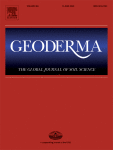Ver ítem
- xmlui.general.dspace_homeCentros Regionales y EEAsCentro Regional Patagonia SurEEA EsquelArtículos científicosxmlui.ArtifactBrowser.ItemViewer.trail
- Inicio
- Centros Regionales y EEAs
- Centro Regional Patagonia Sur
- EEA Esquel
- Artículos científicos
- Ver ítem
Resilient andisols under silvopastoral systems
Resumen
Livestock can affect physical and chemical soil properties, depending on both stocking rates, and intrinsic soil properties. This study aimed to analyze changes in physicochemical properties in volcanic soils under silvopastoral systems. Two contrasting study sites were selected in Patagonia, Argentina, where Nothofagus antarctica silvopastoral systems develop on volcanic soils with different moisture regimes: Udands and Xerands. In each site, four
[ver mas...]
Livestock can affect physical and chemical soil properties, depending on both stocking rates, and intrinsic soil properties. This study aimed to analyze changes in physicochemical properties in volcanic soils under silvopastoral systems. Two contrasting study sites were selected in Patagonia, Argentina, where Nothofagus antarctica silvopastoral systems develop on volcanic soils with different moisture regimes: Udands and Xerands. In each site, four treatments were considered according to canopy openness and accessibility for livestock: closed forests (control), open forests, 5-year exclosures in open forests, and finally, degraded areas affected by large-scale disturbances (i.e., grazing + clear cutting + fire). Localized stocking rate was estimated, and soil properties were analyzed at two depths (0–10 and 10–20 cm). Results showed that physicochemical properties were slightly modified by silvopastoral use, with no critical values found, except for penetration resistance. Soil types behaved differently: while Udands were more fertile and resilient, Xerands were more susceptible to livestock impact, and localized stocking rate was a good short-scale soil degradation indicator for these soils. Although grazing negatively affected soil fertility, increments in carbon stock, nitrogen, and phosphorus were found in Xerands. Besides, an evident improvement in physical soil properties in the short term (5 years) was found in Udands when livestock was excluded. Despite the high resilience of udic volcanic soils under silvopastoral use, total organic matter and organic matter associated with macroaggregates severely decreased. Such decrease occurred especially when grazing was overlapped with other impacts, leading to the loss of forest cover, regardless the soil moisture regime. Nothofagus antarctica forests on volcanic soils seem to form a system capable of sustaining silvopastoral use with controlled stocking rate, but they are highly vulnerable to major impacts.
[Cerrar]

Autor
Gomez, Federico Antonio;
Von Müller, Axel;
Tarabini, Manuela;
La Manna, Ludmila;
Fuente
Geoderma 418 : 115843 (2022)
Fecha
2022-03-20
Editorial
Elsevier
ISSN
0016-7061
Documentos Relacionados
Formato
pdf
Tipo de documento
artículo
Proyectos
(ver más)
INTA/2019-PE-E1-I514-001/2019-PE-E1-I514-001/AR./Manejo de Bosques con Ganadería Integrada (MBGI)
Palabras Claves
Derechos de acceso
Restringido
 Excepto donde se diga explicitamente, este item se publica bajo la siguiente descripción: Creative Commons Attribution-NonCommercial-ShareAlike 2.5 Unported (CC BY-NC-SA 2.5)
Excepto donde se diga explicitamente, este item se publica bajo la siguiente descripción: Creative Commons Attribution-NonCommercial-ShareAlike 2.5 Unported (CC BY-NC-SA 2.5)

